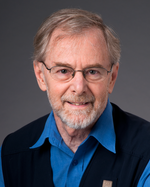1970-74 Postdoc, ANRAO, CSIRO, Parkes, NSW, Australia
1974-79 Postdoc, Mullard Radio Astronomy Observatory, Cavendish Laboratory, Cambridge, UK
1979-1986 Head, Astrophysics, Royal Greenwich Observatory, UK
1986-90 Director, Isaac Newton Group of Telescopes, La Palma, Spain
1990-95 Head, Astrophysics, Royal Greenwich Observatory, UK
1995-98 Director, Royal Greenwich Observatory, UK
1998- Visiting Professor, Astrophysics, University of Oxford, UK
2003- Adjunct Professor, Dept of Physics and Astronomy, UBC
skiing, skating, hiking, classical music
Over the past few years, my students and I have shown how radio AGN (Active Galactic Nuclei, = quasars, radio galaxies) present in large-are sky surveys provide a simple and direct observational approach to cosmic structure studies. Such studies are vital to discover the most basic features of the Universe - mass content and evolution. Our present understanding of this is believed to be detailed, but is based primarily on observations of the cosmic microwave background (CMB) radiation coming from redshifts of about 1000. These CMB observations suggest that we live in a Universe containing 96 percent of its mass/energy in a form we have neither identified, experienced, nor understood. It is therefore imperative to examine the conclusions with whatever other tools we have.
Hand-in-hand with the cosmological investigations, my students and I have advanced the understanding of how different types of AGN are related. It is now commonly accepted that their diverse appearances are largely due to geometrical projection effects: radio quasars are actually radio galaxies seen end on, with the line-of-sight and the effects of relativistic motion changing drastically the appearance of the objects at optical and radio wavelengths. We have taken the first steps to understand the bulk statistics of such models, and a consistent picture has emerged.
With the rapid advance of data, particularly large-area sky surveys such as 2dF and Sloan, it is possible to bring these two aspects of AGN research together. This is the focus of my current research - (a) a new synthesis of the AGN populations to see if unified models really can explain all the features of the AGN populations now apparent to us, and (b) further delineation of large-scale structure using our improved understanding of the AGN populations present in sky surveys.
I currently have one post-graduate student (Tessa Vernstrom).
(1) Practical Statistics for Astronomers gives the Cambridge University Press description of the textbook "Practical Statistics for Astronomers", by J V Wall and C R Jenkins, 2003, Cambridge University Press, 277p, ISBN 0521454166. The book is selling well, with excellent reviews. A second edition nears completion (Aug 2009).
PracStats Solutions gives the solutions to "Practical Statistics" examples (together with extra tips, hints and general descriptive stuff).
(2) JVW bibliography gives J V Wall's publications, complete to October 2008
